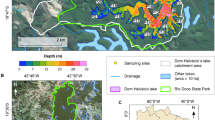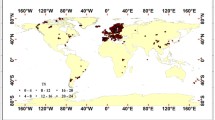Abstract
Purpose
Increases in dissolved organic carbon (DOC) concentrations have been reported in surface waters worldwide in the last 10 to 20 years. The causes behind these increases have been attributed to many factors, including climate change and decreasing depositions of atmospheric sulphate (\( {\text{SO}}_4^{{{2} - }} \)). Trends in DOC concentrations and their potential causal factors were examined in a network of 30 lakes lying in undisturbed temperate and boreal catchments in the province of Quebec, Canada.
Methods
Temporal trends in lake DOC concentrations were analysed with the seasonal Kendall test. For each lake, the variation in DOC concentration over time was assessed in light of the variation in \( {\text{SO}}_4^{{2 - }} \) concentration in precipitation, air temperature, precipitation and solar radiation using the forward stepwise multiple regression.
Results
Between 1989 and 2006, significant increases in DOC were observed in most of the lakes, the mean rate of change being 0.05 mg L−1 year−1. Lake DOC concentrations were significantly explained by different models that yielded a variance explanation ranging from 13% to 77%. The models included long-term temperature variables (i.e. averaged over intervals of 10 years), short-term precipitation variables (i.e. summed over intervals 6 months), radiation (i.e. ice-free period prior to the DOC observation) and precipitation \( {\text{SO}}_4^{{2 - }} \) concentration as explanatory variables.
Conclusion
Temporal changes in DOC concentrations seem more consistent with the evolution of climate parameters rather than \( {\text{SO}}_4^{{2 - }} \) concentrations despite the fact that most lakes were in the process of recovery, showing increases in pH.




Similar content being viewed by others
References
Andersen DO, Gjessing ET (2002) Natural organic matter (NOM) in a limed lake and its tributaries. Water Res 36:2372–2382
Asano Y, Compton JE, Robbins Church M (2006) Hydrologic flowpaths influence inorganic and organic nutrient leaching in a forest soil. Biogeochemistry 81:191–204
Beckage B, Osborne B, Gavin DG, Pucko C, Siccama T, Perkins T (2008) A rapid upward shift of a forest ecotone during 40 years of warming in the Green Mountains of Vermont. Proc Natl Acad Sci USA 105:4197–4202
Bouchard A (1997) Recent lake acidification and recovery trends in southern Québec, Canada. Wat Air Soil Pollut 94:225–245
Burns DA, McHale MR, Driscoll CT, Roy KM (2006) Response of surface water chemistry to reduced levels of acid precipitation: comparison of trends in two regions of New York, USA. Hydrol Proc 20:1611–1627
Cluis D, Langlois C, van Coillie R, Laberge C (1989) Development of a software package for trend detection in temporal series: application to water and industrial effluent quality data for the St. Lawrence River. Environ Monit Assess 12:429–441
Cronan CS (1979) Determination of sulfate in organically colored water samples. Anal Chem 51:1333–1335
Eimers MC, Buttle J, Watmough SA (2008) Influence of seasonal changes in runoff and extreme events on dissolved organic carbon trends in wetland- and upland-draining streams. Can J Fish Aquat Sci 65:796–808
Environment Canada (2005a) 2004 Canadian Acid Deposition Science Assessment (CD-ROM). Environment Canada (February 2005)
Environment Canada (2005b) National Climate Archive. http://www.climate.weatheroffice.ec.gc.ca. Accessed February 2008
Environment Canada (2007) Manual of analytical methods. Quebec Laboratory for Environmental Testing, Montreal
Evans CD, Monteith DT, Cooper DM (2005) Long-term increases in surface water dissolved organic carbon: observations, possible causes and environmental impacts. Environ Poll 137:55–71
Evans CD, Chapman PJ, Clark JM, Monteith DT, Cresser MS (2006) Alternative explanations for rising dissolved organic carbon export from organic soils. Global Change Biol 12:2044–2053
Freeman C, Evans CD, Monteith DT, Reynolds B, Fenner N (2001) Export of organic carbon from peat soil. Nature 412:785
Freeman C, Fenner N, Ostle NJ, Kang H, Dowrick DJ, Reynolds B, Lock MA, Sleep D, Hughes S, Hudson J (2004) Export of dissolved organic carbon from peatlands under elevated carbon dioxide levels. Nature 43:195–198
Gonzalez P, Neilson RP, Lenihan JM, Drapek RJ (2010) Global patterns in the vulnerability of ecosystems to vegetation shifts due to climate change. Global Ecol Biogeogr 19:755–768. doi:10.1111/j.1466-8238.2010.00558
Hongve D, Riise G, Kristiansen JF (2004) Increased colour and organic acid concentrations in Norwegian forest lakes and drinking water: a result of increased precipitation? Aquat Sci 66:231–238
Houle D, Gagnon C, Couture S, Kemp A (2004) Recent recovery of lake water quality in southern Québec following reductions in sulfur emissions. Wat Air Soil Pollut Focus 4:247–261
Hudson JJ, Dillon PJ, Somers KM (2003) Long-term patterns in dissolved organic carbon in boreal lakes: the role of incident radiation, precipitation, air temperature, southern oscillation and acid deposition. Hydrol Earth Syst Sci 7:390–398
Judge GG, Griffiths WE, Hill RC, Lutkepohl K, Lee TC (1985) The theory and practice of econometrics, 2nd edn. Wiley, New York
Keller W, Heneberry J, Leduc J, Gunn J, Yan J, Norman Y (2006) Variation in epilimnion thickness in small boreal shield lakes: relationships with transparency, weather and acidification. Environ Monit Assess 115:419–431
Keller W, Paterson AM, Somers KM, Dillon PJ, Heneberry J, Ford A (2008) Relationships between dissolved organic carbon concentrations, weather and acidification in small Boreal Shield lakes. Can J Fish Aquat Sci 65:786–795
Kemp A (1999) Trends in lake water quality in southern Quebec following reductions in sulphur emissions. Scientific and Technical Report STE-212. Environment Canada—Quebec Region, Environmental Conservation, St. Lawrence Centre, Montreal, Quebec
Krug EC, Frink CR (1983) Acid rain on acid soil: a new perspective. Science 221:520–525
MDDEP (Ministère du Développement durable, de l’Environnement et des Parcs) (2006) Extraction de données particulières, 1988–2006, Banque de données sur la Qualité des Précipitations (BQP). Québec, Ministère du Développement durable, de l’Environnement et des Parcs, Direction du suivi de l’état de l’environnement, Service de l’information sur le milieu atmosphérique (in French)
Molot LA, Dillon PJ (1997) Photolytic regulation of dissolved organic carbon in northern lakes. Global Biogeochem Cycles 11:357
Monteith DT, Stoddard JL, Evans CD, de Wit HA, Forsius M, Hogasen T, Wilander A, Skjelkvale BL, Jeffries DS, Vuorenmaa J, Keller B, Kopacek J, Vesely J (2007) Dissolved organic carbon trends resulting from changes in atmospheric deposition chemistry. Nature 450:537–541
Morris DP, Zagarese H, Williamson CE, Balseiro EG, Hargreaves BR, Moeller R, Queimalinos C (1995) The attenuation of solar UV radiation in lakes and the role of dissolved organic carbon. Limnol Oceanogr 40:1381–1391
Oliver BG, Thurman EM, Malcolm RL (1983) The contribution of humic substances to the acidity of colored natural waters. Geochim Cosmochim Acta 47:2031–2035
Park JH, Matzner E (2003) Controls on the release of dissolved organic carbon and nitrogen from deciduous forest floor investigated by manipulations of aboveground litter inputs and water flux. Biogeochemistry 66:265–286
Pienitz R, Vincent WF (2000) Effect of climate change relative to ozone depletion on UV exposure in subarctic lakes. Nature 404:484–487
Régnière J (1996) Generalized approach to landscape-wide seasonal forecasting with temperature-driven simulation models. Environ Entomol 25:869–881
Rencz AN, O’Driscoll NJ, Hall GEM, Peron T, Telmer K, Burgess NM (2003) Spatial variation and correlation of mercury level in the terrestrial and aquatic components of a wetland dominated ecosystem: Kejimkujik Park, Nova Scotia, Canada. Wat Air Soil Pollut 143:217–288
Rosenzweig C, Karoly D, Vicarelli M, Neofotis P, Wu Q, Casassa G, Menzel A, Root TL, Estrella N, Seguin B, Tryjanowski P, Liu C, Rawlins S, Imeson A (2008) Attributing physical and biological impacts to anthropogenic climate change. Nature 453:353–357
Smemo KA, Zak DR, Pregitzer KS (2006) Chronic experimental NO −3 deposition reduces the retention of leaf litter DOC in a northern hardwood forest soil. Soil Biol Biochem 38:1340–1347
Snucins E, Gunn J (2000) Interannual variation in the thermal structure of clear and colored lakes. Limnol Oceanogr 45:1647–1654
Stoddard JL, Karl JS, Deviney FA, DeWalle DR, Driscoll CT, Herlihy AT, Kellogg JH, Murdoch PS, Webb JR, Webster KE (2003) Response of surface water chemistry to the Clean Air Act Amendments of 1990 Report EPA 620/R-03/001. United States Environmental Protection Agency, North Carolina
Stottlemyer R, Toczydlowski D (2006) Effect of reduced winter precipitation and increased temperature on watershed solute flux, 1988–2002, Northern Michigan. Biogeochemistry 77:409–440
Tipping E, Hurley MA (1988) A model of solid–solution interactions in acid organic soils, based on the complexation properties of humic substances. J Soil Sci 39:505–519
Tranvik LJ (1992) Allochtonous dissolved organic matter as an energy source for pelagic bacteria and the concept of the microbial loop. Hydrobiologia 229:107–114
Vuorenmaa J, Forsius M, Mannio J (2006) Increasing trends of total organic carbon concentrations in small forest lakes in Finland from 1987 to 2003. Sci Tot Environ 365:47–65
Wetzel RG (1992) Gradient-dominant ecosystems: sources and regulatory functions of dissolved organic matter in freshwater ecosystems. Hydrobiologia 229:181–198
Weyhenmeyer GA, Karlsson J (2009) Nonlinear response of dissolved organic carbon concentrations in boreal lakes to increasing temperatures. Limnol Oceanogr 54:2513–2519
Worrall F, Harriman R, Evans CD, Watts CD, Adamson J, Neal C, Tipping E, Burt T, Grieve I, Monteith D, Naden PS, Nisbet T, Reynolds B, Stevens P (2004) Trends in dissolved organic carbon in UK rivers and lakes. Biogeochemistry 70:396–402
Yagouti A, Boulet G, Vincent L, Vescovi L, Mekis E (2008) Observed changes in daily temperature and precipitation indices for southern Québec, 1960–2005. Atmosphere-Ocean 46:243–256
Zhang J, Hudson J, Neal R, Sereda J, Clair T, Turner M, Jeffries D, Dillon P, Molot L, Somers K, Hesslein R (2010) Long-term patterns of dissolved organic carbon in lakes across eastern Canada: evidence of a pronounced climate effect. Limnol Oceanogr 55:30–42
Acknowledgements
This study was funded by Environment Canada. The authors thank the Quebec Laboratory for Environmental Testing of Environment Canada for the analyses. Special thanks go to Michel Arseneau for help with the fieldwork and Pierre Gagnon for support with statistical analysis.
Author information
Authors and Affiliations
Corresponding author
Additional information
Responsible editor: Hailong Wang
Rights and permissions
About this article
Cite this article
Couture, S., Houle, D. & Gagnon, C. Increases of dissolved organic carbon in temperate and boreal lakes in Quebec, Canada. Environ Sci Pollut Res 19, 361–371 (2012). https://doi.org/10.1007/s11356-011-0565-6
Received:
Accepted:
Published:
Issue Date:
DOI: https://doi.org/10.1007/s11356-011-0565-6




